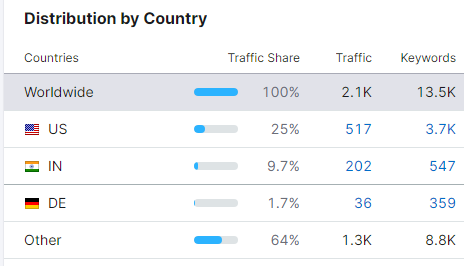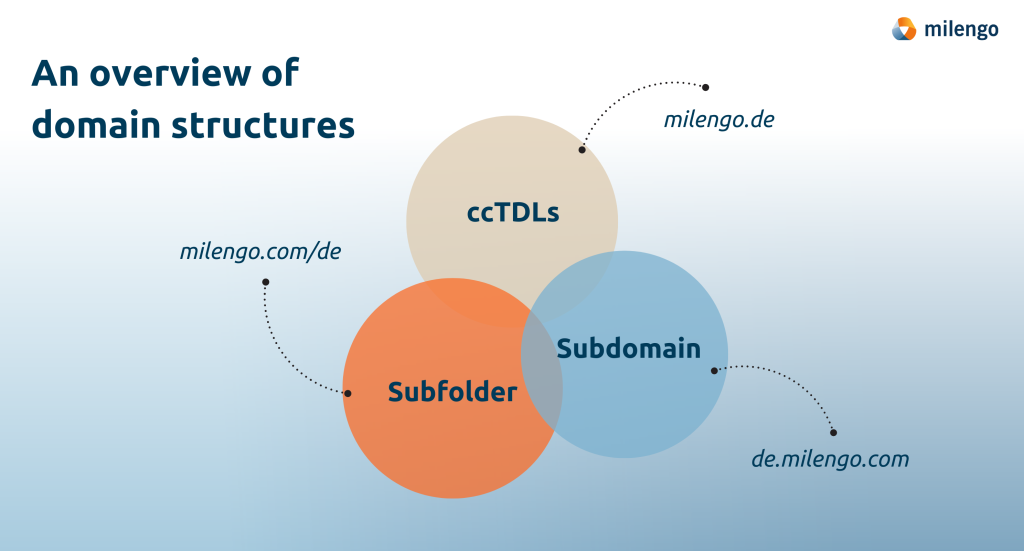Master Your International SEO Strategy with These 9 Best Practices

International companies face the constant battle of getting more traffic to their local and regional websites to strengthen their global market presence. While paid traffic can bring targeted leads to your site, conversion rates of organic traffic are 20-30% higher compared to paid search traffic.
But how can you drive organic traffic internationally? We have the answer – an international SEO strategy. Our detailed walkthrough provides everything you need to know about planning your online presence on the global stage, from the domain structure and technical details to a culturally sensitive content strategy.
What is international SEO?
International SEO is the process of optimizing a website so that it ranks higher in search engines for different countries and languages – thus generating more organic traffic, leads, and sales in international markets.
Companies looking to implement an international SEO strategy for their website need to think beyond linguistic and cultural differences, they also need to think about the technical considerations to optimize for SEO.
What are the benefits of an international SEO strategy?
Having an international SEO in global marketing strategies is particularly beneficial for companies who have a regional or international target market – especially those based in commercial hubs such as Germany, United States, or China. This is because SEO for local markets enables your customers to discover you easily even if they are not aware of your brand.
It is also an opportunity to stand out from the competition, as many international companies (still) do not pursue an international SEO strategy, making them virtually invisible in foreign markets where their brand is not well known.
Similar to economic competition, large markets such as the U.S. or Germany are also extremely competitive from an SEO perspective. This means if you want to rank in the top 3 on Google for coveted keywords such as “CRM software” or “life insurance”, you need to continuously invest in content creation and backlink building.
In this context, international SEO can provide a competitive advantage by targeting language “niches”. English is the most used language for websites, making up 52% of websites, followed by Spanish in second place with 5.5% of websites.
This massive discrepancy shows there is less competition to rank in non-English speaking markets. This means spreading your SEO efforts between different countries and languages can increase your website’s organic traffic, which in turn helps to boost your domain profile and SEO rankings.
The most common fails in internationalization
We’d like to start by highlighting some of the typical mistakes made in international search engine optimization:
- The website is translated without focusing on SEO or solely using AI.
- The technology behind the localized website is not optimized.
- No local keyword research is done.
- The localized content is reviewed by a non-native speaker.
- Content is created for the target market and then “forgotten”.
This blog will explain how to avoid these mistakes.
9 best practices for your international SEO strategy
1. Analyze the market
The first logical step in your international SEO strategy is to decide on an international market. Make sure to include SEO criteria in your market analysis. Which regions generate a large volume of search queries for your products or services? And where is competition particularly low on Google and other search engines?
SEO tools such as Semrush also allow you to analyze your competitors’ websites and gain insight into their global market presence. In the example below, the website of a software provider has a strong presence in India. This could also be an interesting market for industry competitors in terms of SEO potential.

Source: Semrush
2. Country vs language focus
Next, you need to determine whether the new versions of the website should be based on languages or countries.
Country-specific websites naturally have the advantage that you can target your customers at the local level – for instance, with prices in the local currency.
Keep in mind that if you target a country with multiple official languages, your new online presence will have to cover all of them. For example, targeting Belgium would mean your international SEO strategy will need to include French and Dutch.
Language-specific websites allow you to target audiences who speak the same language but live in different countries. This allows companies to maximize their reach while minimizing the number of website variations to manage.
3. Pick the right domain structure
Picking the right domain structure is critical if an international SEO strategy is to be successful. There are three approaches you can take:

Country code top-level domains (ccTLDs) are used when content is geared towards countries. They convey a clear focus on the local market, which increases user trust and in turn improves click rates. This is why ccTLDs are especially popular in the highly competitive e-commerce sector. Search engines also rank these country variants higher. For example, milengo.de ranks higher on google.de than milengo.at, even though both are in German.
However, ccTLDs entail additional costs – the new domains must be purchased, and better servers are needed. In addition, website administration becomes more complicated. For example, site design updates must be installed on each individual country domain. SEO authority also needs to be built up from scratch for each domain. A milengo.de site cannot benefit from the link power of a milengo.com site, which makes it necessary to build local backlinks.
Subdomains are an option for generic top-level domains (for example, milengo.com, milengo.net, milengo.org). A subdomain es.milengo.com makes sense for a Spanish audience, but es.milengo.de would invariably confuse users. Subdomains make it easy to separate content and manage the different language versions. However, it can be more difficult to establish a strong domain ranking for subdomains.
Subfolders (for example, milengo.com/de) are another option. They are popular because they use the authority of the top-level domain and are easier to manage than ccTLDs. However, it can be more difficult to signal a clear geographical focus.
4. Set up your technical architecture
Even the best content is doomed to fail without the right technical foundation. This is because it’s not just the frontend of websites that need to be optimized for international rankings but the backend too.
hreflang
hreflang tags ensure that search engines display the correct language and country versions of your website. Seeing that multilingual websites tend to have a lot of similar (or identical) content, hreflang tags avoid SEO penalties from duplicate content and maximize SEO efficiency by attracting targeted traffic from different markets and languages. Google’s Senior Search Analyst John Mueller once described hreflang as “one of the most complex aspects of SEO” – so invest the time in doing a deep dive here.
Page load time
Webpages hosted internationally sometimes take longer to load for users from abroad, which can indirectly affect your ranking in the target market. Using a content delivery network (CDN) is recommended to prevent this from happening. A CDN is a network of servers in different geographical locations that load content faster by delivering it from a location close to the visitor.

CDN-Architektur. Source: Seobility (License: CC BY-SA 4.0)
Local link building
New top-level domains initially have no SEO authority and must build it up over time. It is therefore important to build high-quality local backlinks to your website – ideally by producing high-quality content for the respective country that other sites would want to reference to.
When doing this, it is important to make sure that newly generated backlinks have a follow link to the respective country domain.
5. Optimize for local search engines
Despite the meteoric rise of AI, Google is still the number one search engine, commanding over 80% of the global market share. However, the search giant is not at the top of the mountain in every country. For example, Baidu is the most popular in China, Yandex dominates in Russia, and South Koreans prefer Naver.
Each of these search engines has its own ranking factors. Baidu, for instance, focuses on mobile-first content, while Yandex does not support JavaScript-based websites. This means if Google isn’t the go-to for your target market, your international SEO strategy must implement the right tactics to optimize your website for other engines.
Performing a detailed market analysis will help you to understand the differences and adapt your strategy accordingly.
6. Research local keywords
Now that you have your technical foundation, you need to perform keyword research for each of your target markets.
Keyword sets for two different countries can differ significantly, both in terms of the search terms themselves and the search volume.

Tip:
Use established SEO tools such as Google Keyword Planner, SEMrush, or Sistrix to analyze your keyword set.
Don’t translate your keywords literally. Research country-specific search terms and expressions based on local user trends. Work with native speakers in the target country to ensure the keywords are relevant and suitable for international SEO.
Here are some other recommendations on what else you could do:
- A thorough SEO competitor analysis will help you understand who your main competitors are in your target market and what search tactics they are using.
- Don’t forget that markets vary in size and sometimes have widely varying keyword potential. If the original website is in English, then you can assume that the ranking potential in other languages is significantly lower. Here are two examples:
- There are 12,000 search queries per month for the keyword “crm system” in the U.S., but only 110 in Slovenia.
- It is often difficult to find enough relevant keywords for small markets when it comes to niche or B2B topics. An SEO-related keyword such as “international keyword research” has a search volume of 70 in English. In German, however, there is no equivalent keyword that ranks, meaning a blog post about this topic would not impact a German website much from an SEO perspective.
7. Perform a content audit
Let’s assume you already have a website in your domestic market that draws a high volume of search traffic, features a popular blog, and has generated a ton of backlinks. Can you simply use this as a blueprint for SEO success in other foreign markets?
Yes, but only to a limited extent. You need to perform a content audit to determine which pages of your website also work in international markets, what content needs to be adapted for the local audience, and what needs to be created from scratch. This audit is based on the following criteria:
Which content performs best? And which is most critical to success?
Many companies are unaware of which pages on their website generate the most traffic. Google Analytics or a professional SEO tool can provide an answer here. You should also prioritize content that is central to your business or important for conversions. For example, a light-hearted blog piece will generate more clicks than a specialized case study, but the latter will be more effective in convincing customers to opt for your products and services.
What is relevant to your target market?
Analyze which content topics are actually relevant for search engine optimization in the target market and which are not. The socioeconomic and cultural differences of countries will play a role here. For example, an article about new EU laws on CO2 emissions would be highly relevant for European audiences but might not be as important to American or Asian audiences.
Along the way, you might also discover that some content does not perform well in your home market and should not be migrated at all.
What needs to be done from scratch?
The high-level keyword research you carried out may have identified topics that are important to audiences abroad that you have not covered yet. Use these insights to guide the creation of fresh content tailored to your local audience’s interests and needs.
8. Invest in professional localization
Now it’s time to get down to business – creating the content for your multilingual website! Despite the focus on SEO, don’t forget that you are creating content for your customers first and foremost, not Google. Focusing on the user experience is what will pay off in the long term.
Customers who are expected to invest a lot of money in a product – say, a luxury watch or expensive software – first need to trust in your brand before making their purchase. One way to do this is to speak to them in their language.
Professional localization does not mean translating everything word-for-word. It means taking cultural differences and local factors into account. There are three ways to do this: SEO-focused translation, transcreation, and copywriting.
SEO translation
Much of your content can be localized with standard marketing translations. For SEO-relevant pages, you should provide translators with an SEO briefing. And don’t forget to always have your keywords localized by native speakers!
Here’s an example to illustrate why. The English word projector can be translated into German either as Projektor or Beamer. While Projektor is a more obvious literal translation for non-native speakers, Beamer is the more commonly used term by consumers, and is therefore a more lucrative search term:

Source: Semrush
Do you need professional translations optimized for search engines? Partner with a marketing-savvy translation agency such as Milengo for marketing materials that hit your objectives across markets.
Transcreation: translations uniquely tailored to your target market
In many cases, marketing copy cannot be translated directly but instead needs to be adapted to the target culture. For instance, an international fashion brand will focus its sales and content strategy more on winter clothing in Norway than let’s say in Spain.
This means that in a transcreation – or a “creative translation” – the linguist rewrites entire sections of text, inserts local examples, and adapts the tone where needed.
Create new local content with copywriting
Customers’ needs differ from country to country. That means parts of your content need to be rewritten for the target market.
For example, many German companies view data protection as one of their top priorities. This means that software-as-a-service providers should specifically address how they protect customer data on their German website.
Don’t fall into the AI trap
It sounds tempting to have an AI-powered machine translation (MT) service translate your entire website in just a couple of clicks. But that could not be further from international SEO best practices. In fact, Google now penalizes bulk AI-generated content. And that happens on top of the clunky wording and major translation errors that diminish the user experience and trust in your brand.
Make no mistake: AI-powered MT is still a valuable resource – especially for translating less visible parts of your website or product documentation. And even with an AI workflow, a predefined text quality can be ensured by post-editing the output using ISO-certified processes.

Tip:
Take a look at Google’s spam policies to stay updated on the most current guidelines for content generation with AI.
9. Continue creating SEO-optimized content
To borrow a phrase, SEO is a marathon, not a sprint. Localizing your website is only the beginning – the work is far from done.
You now need to keep expanding, maintaining, and updating your country-specific content as new, relevant content also helps to increase search rankings. This should ideally be done by a native-speaking content marketer or at least someone who can review localized content.
To streamline the management of multilingual websites, many companies pair content management systems such as WordPress with translation management systems such as memoQ.
Conclusion

Having an international SEO strategy opens the door to major opportunities for companies to expand their reach and tap into new markets. Careful planning and implementation will enable you to optimize your website for an international audience and maximize your growth potential.
The key to an international SEO strategy is having the right technology, exceptional content, and professional translations. That’s where Milengo comes in. Our team of experienced SEO translators can help you craft a winning international SEO strategy that gets your website seen by the right people in the right markets. Let’s chat about your goals and see how Milengo can help you take your business global!
Ihr News Roundup zum Thema Lokalisierung
Unser Newsletter liefert brandaktuelle Infos und Tipps rund um Lokalisierung direkt in Ihr Postfach – unterhaltsam aufbereitet von echten Branchenexperten!
Calculate your REAL translation costs
Get free quote




